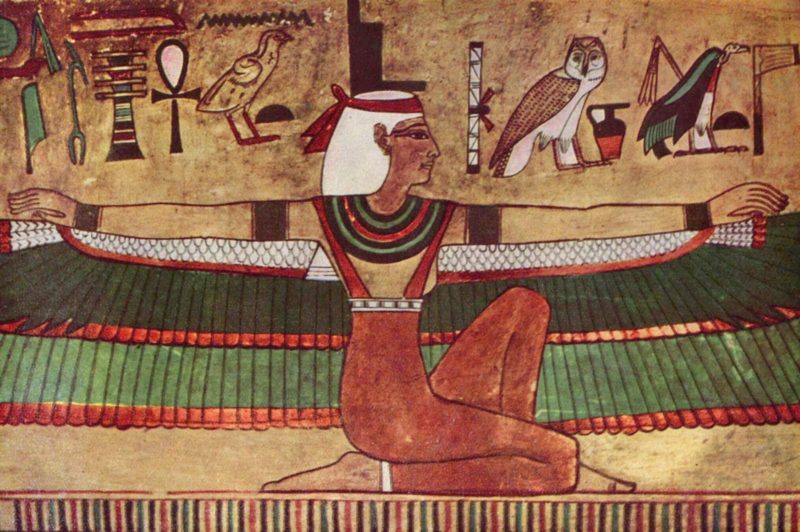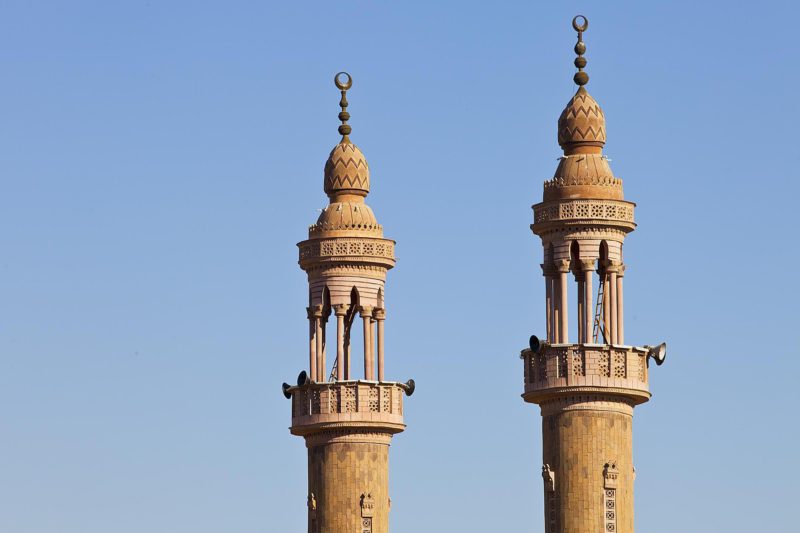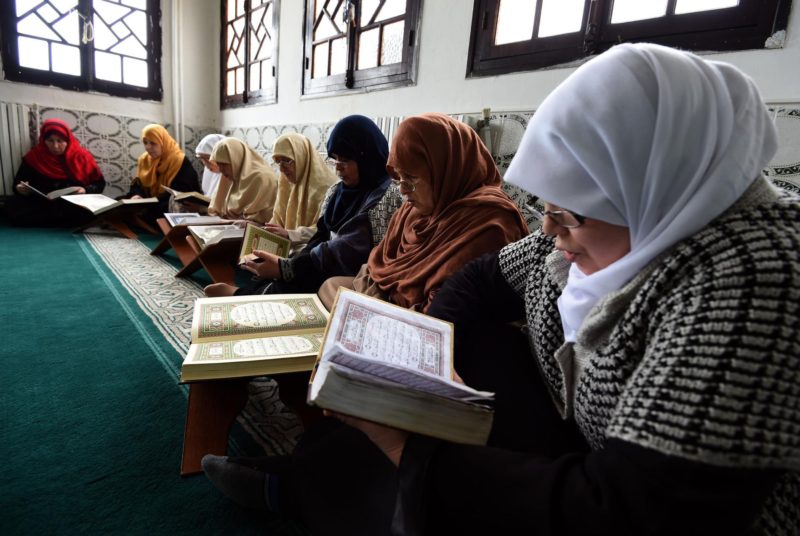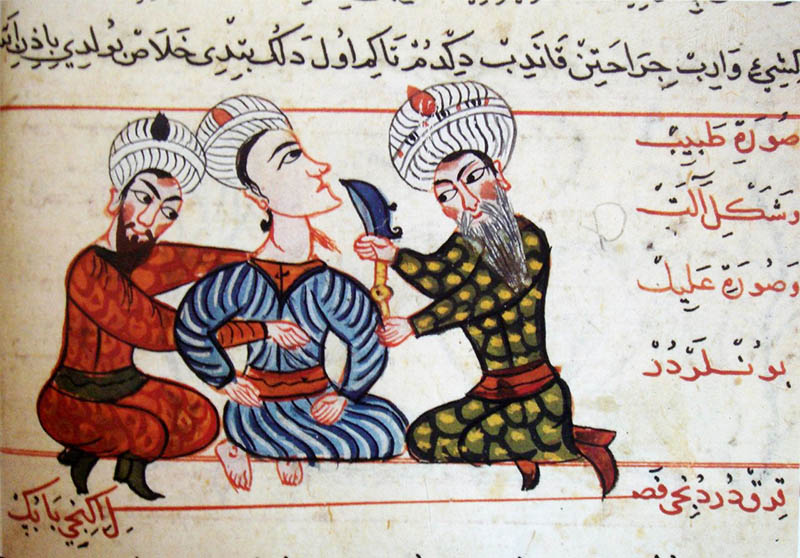Why Arab Women in History Were a Shame to Family and Were Soled or Buirred Alive
Islam placed paradise under the feet of women when they became mothers; they became the reason why fathers would enter paradise, and were besides fabricated such an integral part of a husband's organized religion that without honoring his wife, his faith remained incomplete. It was with this newly acquired status that women soared high and made their distinguishing mark in history, so as to not be left behind when the greats of Islam were glorified, writes ZAINAB ALIYAH.
As the shrill cries of a newborn filled a Makkan household, the father would feel a chilling sensation run downward his spine fifty-fifty as he is informed of the nascency of a daughter. He could not fathom a worse fate.
"He hides himself from the people, because of that which is appear to him. Shall he keep it with disgrace or bury it (alive) in the grit?"[1]
 And so he slips away in the nighttime to stash his infant daughter in a deep grave never to see, or hear, her over again. This was Arab society before 621 CE, where a female wasn't even worth keeping alive. Even if she did alive, it would be a life without any opportunities – indeed, a living decease. And then, in the Year of the Elephant, came Muhammad, may peace and the blessings of Allah (swt) be upon him, as a mercy to mankind and a low-cal for humanity. He made men realize that they had to fear a day 'when the female babe buried alive shall be asked almost the sin for which she was killed' [2] and on that solar day, every perpetrator of this evil shall have to business relationship for this heinous human action.
And so he slips away in the nighttime to stash his infant daughter in a deep grave never to see, or hear, her over again. This was Arab society before 621 CE, where a female wasn't even worth keeping alive. Even if she did alive, it would be a life without any opportunities – indeed, a living decease. And then, in the Year of the Elephant, came Muhammad, may peace and the blessings of Allah (swt) be upon him, as a mercy to mankind and a low-cal for humanity. He made men realize that they had to fear a day 'when the female babe buried alive shall be asked almost the sin for which she was killed' [2] and on that solar day, every perpetrator of this evil shall have to business relationship for this heinous human action.
Islam arrived as guidance for all flesh and every bit a catalyst in the lives of women, transforming their status overnight. Rights of women, a concept previously unheard of – or even thought near – were being upheld and protected. From beingness only a mere commodity in the households, wives became a source of dignity. The Companions saw the Prophet (saws)'s beloved for his daughters and his warm behavior with them and were stunned at the fact that information technology was even possible to show females such affection.
The Prophet (saws) taught them that in that location is no difference in the worth between believers on the basis of gender. Both enjoy the same rights and duties to learn and teach. Women take the same duty every bit men to restrain themselves and others from evil and encourage themselves and others towards good. Islam placed Paradise under their feet when they became mothers; they became the reason why fathers would enter paradise, and also such an integral function of a hubby's faith that without honoring his wife, his faith remained incomplete. It was with this newly acquired status that women soared loftier and made their distinguishing marker in history, then equally to non be left behind when the greats of Islam were glorified.

Muslim women, contributed to the legacy of Islam as scholars, jurists, rulers, benefactresses, warriors, businesswomen, and legal experts. The Prophet's household was looked up to by all his Companions as a buoy of guidance. His wife, Khadija (ra), who was more than his confidante and companion, a wealthy baron and trader, supported him morally and financially when he was granted prophethood; Aisha bint Abu Bakr (ra), transmitted expanses of knowledge from him, became a great jurist and scholar; Umm Salama (ra)'due south counsel was accepted past the Prophet himself, at the time of the treaty of Hudaibiyyah; Hafsa (ra), daughter of Umar ibn Al-Khattab was the first person to be entrusted with the written Qur'an after the decease of her father.
Preservation of 'ahadith'
The contribution of women in the preservation of ahadith has been great indeed. A survey of the texts reveals that most of the important compilers of ahadith from the earliest period received many of them from women teachers, as the firsthand authorities. Ibn Hajar studied from 53 women; Equally-Sakhawi had ijazas from 68 women and As-Suyuti studied from 33 women, a quarter of his shuyukh.
In the 4th century, we find Fatima bint Abdur-Rehman, known as As-Sufiyyah on account of her great piety; Fatima grand-girl of Abu Dawud of Sunan fame; Amat al-Wahid, the granddaughter of the distinguished jurist al-Muhamili; Umm al-Fath Amat Equally-Salam, the daughter of the judge, Abu Bakr Ahmad; Jumuah bint Ahmad, whose classes were always attended by reverential audiences.

Fathima bint al-Hasan ibn Ali Ad-Daqqaq al-Qushayri was a hadith scholar of the fifth and 6th centuries, who was historic not merely for her piety and mastery of calligraphy, but also for her knowledge of ahadith and the quality of the isnads (chains of narrators) she knew. Fifty-fifty more distinguished was Karimah al-Marwaziyyah, who was considered the best authority on the Sahih of Al-Bukhari in her ain time. Abu Dharr of Herat, i of the leading scholars of the period, fastened such great importance to her authority that he advised his students to report Sahih under no one else because of the quality of her scholarship. Amid her students were Al-Khatib al-Baghdadi and Al-Humaydi.
Fatima-bint-Muhammad, known equally Shahdah, the Author, received the proud title ofMusnida Asfahan (the great hadith authority of Asfahan). She founded a Sufi lodge which her hubby endowed most generously. Her lectures on Sahih al-Bukhari were attended by a large crowd of students and many even falsely claimed to have been her students.
Well-known as an authority on Sahih al-Bukahri is Sitt al-Wuzra, who, as well her mastery of Islamic police, delivered lectures on the Sahih in Damascus and Arab republic of egypt. Likewise, Umm al-Khayr Amat al-Khaliq is regarded as the concluding neat hadith scholar of the Hijaz.
In seventh century Damascus, at that place was Umm al-Darda, a prominent jurist whose students included Abdul Malik ibn Marwan, the so Caliph himself. She used to teach hadith andfiqh, at the mosque. Ilyas-ibn-Mu'awiyah, an important scholar of the time and a judge of undisputed merit, considered her to be superior to all the other hadith scholars of the period.
Aisha bint Sa'advertisement bin Abi Waqqas was a jurist and scholar and likewise the teacher of the renowned scholar, Imam Malik, the founder of the Maliki School of Fiqh. Sayyida Nafisa, the great granddaughter of the Prophet Muhammad (saws), and daughter of Hassan bin Ali bin Abu Talib , was a teacher of Islamic Jurisprudence, whose students travelled from faraway places and one of them was Imam Shafi'i, some other cracking scholar, and founder of the Shafi'i School of Fiqh. She financially sponsored his education for him.
Scholar women

Ashifa bint Abdullah was the kickoff Muslim woman to exist appointed past Caliph Umar ibn Al-Khattab as market inspector and manager. Amra bint Abdurrehaman was one of the great scholars of the eighth century who was a jurist, a Mufti, and a scholar of ahadith. During the time of Caliph Umar bin Abdul Aziz, she was considered a great authority on traditions related past A'isha (ra), the wife of the Prophet (saws). Among her students was Abu Bakr ibn Hazim, the celebrated judge of Madina who was ordered by Caliph Umar bin Abdul Aziz to compile all the ahadith on her authority.
Aisha bint Muhammad ibn Abdul Hadi in Damascus was a scholar who taught many prominent Muslim male person scholars and also possessed the shortest concatenation of narrators dorsum to the Prophet Muhammad (saws). She taught Ibn Hajar al-Asqalani, the greatest scholar of her time. Fatima al-Batayahiyyah, was a distinguished elderly woman of the eighth century who taught her students the celebrated works of Sahih al-Bukhari for days on end in the Prophet's mosque itself.
In the 9th century, there was Fatima al-Fihriyya in Fez, Morocco, who founded the al-Qarawwiyyin mosque.[iii]
Established in the yr 859, the Qarawwiyyin mosque, through which Standard arabic numbers became known, and used, in Europe, had the oldest and peradventure the get-go academy in the globe and is nonetheless functioning. Students travelled here from all over the globe to study Islamic studies, languages and sciences.
Fatima of Cordoba was a tenth century librarian who oversaw 70 public libraries containing 400,000 books. In the eleventh century, was Banafshaa' ar-Rumiyya, who restored schools, bridges and public housing for homeless women in Baghdad.
After them were Abidah al-Madaniyya, Abdah bint Bishr, Umm Umar Ath-Thaqafiyyah, Zaynab, the granddaughter of Ali ibn Abdullah ibn Abbas, Nafisah bint al-Hassan ibn Ziyad, Khadijah Umm Muhammad, Abdah bint Abdar Rahman and many other women who excelled in delivering public lectures on ahadith . Abidah started out equally a slave owned past Muhammad ibn Yazid. She learned a large number of ahadith and related 10,000 ahadith on the authorization of her Madani teachers.
When she was given by her principal to Habib Dahhun, the bully hadith scholar of Spain, on his visit to the holy urban center of Jerusalem, he was so impressed by her learning that he freed her, married her and brought her to Andalusia.
Zaynab bint Sulayman, by contrast, was a princess by birth. Her father was a cousin of As-Saffah, the founder of the Abbassid dynasty, and had been a governor of Basrah, Sultanate of oman, and Bahrain during the caliphate of Al-Mansur. Zaynab, who received a fine education, caused a mastery of ahadith and gained a reputation every bit one of the most distinguished women scholars of the time as well counted many important men amid her pupils.
In the twelfth century, there was Shuhadah bint Ahmad al-Ibrii, who studied in Baghdad with prominent scholars of ahadith and became a slap-up scholar and jurist herself and was well-known every bit the 'Pride of Women.' Zainab bint Kamal taught more than 400 books ofahadith in some of the most prestigious bookish institutions in Damascus and exhibited exceptional patience which won the hearts of her students. There was Fathima bint Muhammad al-Samarqandi, a jurist who brash her more famous husband on how to issueFatwas. More recently, in the nineteenth century, history saw the growth and success of Nana Asma'u of Nigeria; a poet, teacher, scholar and advisor to her male parent.
Sultanas
Women who stand up out as rulers include Arwa al-Sulayhi, an eleventh century Yemeni who ruled for 71 years and was known every bit the Noble Lady; and Sultana Shajarat al-Durr, who took control of Arab republic of egypt after the death of her husband in the thirteenth century. Dhayfa Khatun, the niece and daughter-in-law of Salah al-Din al-Ayyubi, afterwards the death of her son, King Abdul Aziz, became the queen of Aleppo and ruled for six years.[4] During her reign, she faced threats from the Crusaders, Khuarzmein, Mongols and Seljuks. In addition to her political and social part, she even sponsored pedagogy in Aleppo where she founded 2 schools.
Sitt al-Mulk was a Fatimid princess from Arab republic of egypt, whose good administration was in accordance with Islamic laws.
Queen Zubayda, wife of the ninth century Caliph, Harun Ar-Rasheed, is famous for her contributions building h2o resource and invitee houses for pilgrims along major routes leading to Makkah. She was an intellectual who expressed her political views in public and even supported poets and writers regardless of their religion, religious scholars and the needy. The famous Zubayda spring in the outskirts of Makkah nonetheless carries her proper name.
Closer dwelling house in Bharat nosotros had Razia Sultana, the only female person to sit down on India's throne in Delhi for four years in the thirteenth century. Firishta, an eighteenth century historian, writes: "…Razia, though a adult female, had a man's head and heart and was better than twenty such sons."
Hurrem Sultan (1500CE), also called Roxelana, was enslaved in the Crimean Turks raids on Ukraine, during the reign of Yazuz Sultan Salim and was presented at the Ottoman palace to King Suleyman, who later married her. She is the founder of a number of institutions which include a mosque complex in Istanbul which is home to a Madrasa and a public kitchen;cifte hamam (double bathhouse for both men and women), two schools and a women's hospital. She also built four schools in Makkah and a mosque in Jerusalem.
The education of girls
 Amina was the queen of Zazzua, a province of Nigeria, in the sixteenth century. At the historic period of sixteen, she became the heir-apparent to her mother. Amina chose to larn armed forces skills and emerged as the leading warrior of Zazzua cavalry. In her reign of 34 years, she expanded the territory to its largest size ever. Her primary focus was on forcing local rulers to accept vassal status and permit condom passage to Hausa traders. She is credited with popularizing of the earthen wall fortifications which became characteristic of Hausa states since then. She ordered the edifice of defensive walls around each armed forces camp that she established. Later towns grew within these walls and many of them are still in existence and are known as Amina's walls.
Amina was the queen of Zazzua, a province of Nigeria, in the sixteenth century. At the historic period of sixteen, she became the heir-apparent to her mother. Amina chose to larn armed forces skills and emerged as the leading warrior of Zazzua cavalry. In her reign of 34 years, she expanded the territory to its largest size ever. Her primary focus was on forcing local rulers to accept vassal status and permit condom passage to Hausa traders. She is credited with popularizing of the earthen wall fortifications which became characteristic of Hausa states since then. She ordered the edifice of defensive walls around each armed forces camp that she established. Later towns grew within these walls and many of them are still in existence and are known as Amina's walls.
At that place was a family of women who ruled over Bhopal from 1819 to 1924, the final of who was Begum Kaikhursau Jahan. This family was reputed for improving the railway, waterworks, a postal system and transport lines in the vicinity.
Muslim women ensured that they left behind a legacy when it came to intellectual and academic feats. Sutayta al-Mahamili, a mathematician lived in the 2nd one-half of the 10th century, and came from an educated family in Baghdad. She excelled in many fields such as Arabic literature, hadith and jurisprudence. She invented solutions to many equations which accept been cited past other mathematicians which announce aptitude in algebra. She was praised by historians such as Ibn al-Jawzi, Ibn al-Khatib Baghdadi and Ibn Kathir.
Women of Al-Andalus
Labana of Cordoba (tenth century, Spain) was well-versed in the exact sciences of mathematics and could solve the most complex geometrical and algebraic issues known at that fourth dimension. She was employed every bit the individual secretary to the Umayyad Caliph of Islamic Spain, Al Hakam the 2d.
Ayesha, girl of Prince Ahmed of Andalus, who lived in the eleventh century excelled in rhyme and oratory. Her verses aroused the tumultuous enthusiasm of the otherwise grave poets of Cordoba and her library was one of the finest and most complete in the kingdom.
Wallada, a princess of Almohads during the eleventh century, was renowned for her knowledge of poetry and rhetoric; her conversations were remarkable for their depth and brilliance. At the bookish contests of Cordoba, the capital which attracted the learned and the eloquent from every quarter of the Iberian peninsula, she never failed, whether in prose or in poetical limerick, to out-altitude all competitors of the eleventh century.
Al Ghazaniya and Safia, both of Seville, were distinguished for their poetical and oratorical genius of the eleventh century. The latter was unsurpassed for the beauty and perfection of her calligraphy; the splendid illuminations of her manuscripts were the despair of the virtually accomplished artists of the historic period.
The literary attainments of Miriam, the gifted girl of al-Faisuli were famous throughout the Andalus. The caustic wit in the satire of her epigrams were unrivalled past the finish of the eleventh century.
In the art of calligraphy, i name that keeps recurring is that of Thana, a slave in the household of Ibn-Qayyuma. Ibn Qayyuma was the tutor of 1 of the sons of Caliph Mansur, of the eighth century. Of the two he sent to exist trained under the leading calligraphist of the day, Ishaq-bint-Hammad, one was the slave girl Thana, who his pupils say, 'wrote the original measured scripts, never since equaled.'
Umm-al-Sa'd of the eleventh century was famous for her familiarity with Muslim traditions. Al Fihrist-ibn-al-Nadim, an eighteenth century historian in his book names women with a varied range of skills. Two are grammarians – a much respected branch of cognition, related to the utilise of the full range of excellence of the Arabic linguistic communication. There was a woman scholar of Arab dialects, of the eleventh century, 'whose origin was among the tribes.' And another, 'acquainted with tribal legends and colloquialism' and a tertiary i wrote a book entitled, 'Rare Forms and Sources of Verbal Nouns.' In a different field, Arwa, wrote a book on 'sermons, morals and wisdom.'
An Indian, past the name of Rasa, was the author of a book on medical care and the treatment of women. Her volume is listed among medical works available in Standard arabic. Mariyah-al-Qibtiyyah, an Egyptian, wrote on Alchemy in the 7th century.
The making of astrolabes, a co-operative of practical scientific discipline which is given bully status, was practiced by Al Ijiliyyah bint al-Ijili al-Asturlabi, who followed her father's profession in Aleppo and was employed in the court of Sayf-ad-Dawla, ane of the powerful Hamdanin rulers in northern Syrian arab republic, in the tenth century CE.
Physicians and doctors

The Sharia requires Muslims to have great business for society in all spheres of life. With the arrival of Islam, women were able to practice equally physicians and treat both men and women particularly on the battlefields. The title of the first nurse is credited to Rufayda bint Sa'ad al-Aslamiyya who lived at the aforementioned time as the Prophet (saws). She nursed the wounded and the dying in the battleground during the Battle of Badr on 13th March 624 CE. She learned near of her skill from assisting her begetter, Sa'ad al-Aslami, who was a md.
Al Shifa bint Abdulla al-Quraishiyya al-Adawiyah was amidst the wise women of the time. She was involved in public assistants and skilled in medicine. Her proper name was Layla but, and received the title 'Al Shifa' which ways 'The Healing.'
Nusayba bint Ka'ab al-Mazneya, offered her medical services during the Battle of Uhud; Umm-east-Sinan Al-Islami, requested the permission of the Prophet to get out into the battlefield and assist the wounded soldiers and provide water to the thirsty; Umm Warqa bint Harith, who participated in compiling the Qur'an, nursed those wounded at the Battle of Badr.
Nusayba bint al-Harith, too known equally Umm al-Athia, took care of casualties on the battlefield and took care of providing them with food and water and first aid and, moreover, performed circumcision.
Political rulers
The most recent account of a scholar, who dedicated her life to Islam, is that of Zainab al-Ghazali. Born in 1917, in Egypt, she was an activist and was closely associated with theMuslim Brotherhood. Her begetter encouraged her to become an Islamic leader, citing the case of Nusayba bint Ka'ab al Muzaniyya, a woman who fought aslope the Prophet Muhammad in the Battle of Uhud. At the age of nineteen, she founded the Jama'at al-Sayyidat al-Muslimaat (Muslim Women's Association) which had a membership of iii one thousand thousand throughout the country by the time information technology was dissolved past regime gild in 1964. She was invited by Hassan al-Banna, the Founder of the Muslim Alliance to merge theJama'at with his organization. She refused his offer in gild to retain her autonomy. Still, she did have an oath of personal allegiance to him. Her weekly lectures attracted a crowd of approximately 5000 people. Also offering lessons for women, the Jama'atpublished a mag, maintained an orphanage, assisted poor families and mediated family unit disputes. It took a political stance, enervating that Egypt be ruled co-ordinate to the Qur'an.
Later the assassination of Hassan al-Banna, she played a pivotal role in regrouping theAlliance in the 1960s. She was imprisoned in the year 1965 and was sentenced for 25 years, but was released under Anwar Sadat's presidency. While in prison house, al-Ghazali and members of the Brotherhood underwent many inhumane punishments. During these periods of hardship, it is said that she had visions of Prophet Muhammad (saws) and also experienced some miracles as she got nutrient, refuge and forcefulness in those difficult times. She has authored a book based on her experiences in jail, which was later translated into English as Return of the Pharaoh. She died on threerd Baronial 2005, anile 88 years.
Dr. Akram Nadwi, writer of a 40-volume drove of women scholars in Islam, Al-Muhaddithat, has, in his inquiry, unearthed the accounts of many such scholars whose legacy and contributions are forgotten by now. According to him, the electric current emphasis placed on the subjugation of women in Islamic society made it really important to seek out the real historical records of women's place in Islam. Every bit the Shaykh describes:
"Initially I thought there might exist about 30 to 40 women, but every bit the research progressed, the accounts kept growing until I realized I had no less than 8,000 biographical accounts of Muslim women who played major roles in the preservation and evolution of Islamic traditions since the fourth dimension of the Prophet (PBUH) himself. The women I encountered were far from mediocre when compared to men and, indeed, some excelled way beyond their male person contemporaries. These were exceptional women who non only participated in order merely actively reformed it. Nearly striking was their caliber for intellectual accomplishment and the respect and recognition they received for it."
An Elegy Written in a Country Churchyard is an eighteenth century poem which laments the villagers buried in a churchyard. The poet, Thomas Gray, says: "Many villagers could take been Milton, if but they had had the take chances."
Such is the instance with Muslim women as well. If presented with the correct kind of opportunities and given a reasonable dose of motivation, 8,000 may very well turn out to be a much understated supposition as regards the number of female scholars Islamic civilization may, and can, put forth.
Bibliography
- www.pakpassion.com
- www.wikipeida.org
- http://www.muslimheritage.com
- www.bewley.virtualve.net
- http://sunnah.org
- Al-Muhaddithath by Dr. Akram Nadwi
- Ishraq al Ma'ani, Juz 30, by Syed Iqbal Zaheer
[1] The Qur'an; Surah An-Nahl: 59
[ii] The Qur'an, Surah Takweer: 8-9
[3] FSTC, Al Qarawiyyin Mosque and Academy (published 20 October 2004)
[4] El-Azhari, Taef Kamal, "Dhayfa Khatun, Ayyubid Queen of Aleppo 634-640", Annals of Japan Association for Middle E Studies no.xv 2000.
Source: youngmuslimdigest.com
Source: https://funci.org/great-women-in-islamic-history-a-forgotten-legacy/?lang=en
0 Response to "Why Arab Women in History Were a Shame to Family and Were Soled or Buirred Alive"
Post a Comment